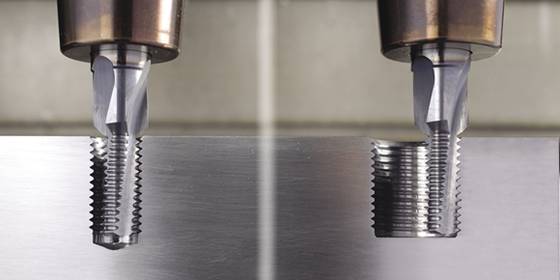How to Make Threads - A Machining Guide
From fasteners to leadscrews, threads are one of the most common mechanical elements. But how exactly are threads made? Here's an overview of the key threading methods used in machining.

Thread Cutting
Thread cutting is the most direct method of creating external and internal threads. On lathes, the workpiece rotates as a cutting tool moves parallel to the axis of rotation to cut the thread profile. China CNC service cutting on mills involves rotating the cutting tool as the workpiece feeds past. Common thread-cutting approaches include:
- Single point - Uses one cutting tool to create the thread form.
- Chasing - Uses a chaser tool containing multiple cutting teeth.
- Thread milling - Mills threads by interpolating rotating cutters.
Thread cutting produces accurate, strong threads. However, it is a relatively slow method requiring skilled operators.
Thread Rolling
Thread rolling displaces and cold works material using hardened steel dies to form threads. On screws and bolts, the blank rotates between two dies that mirror the thread profile. The dies apply extreme pressure to roll the threads rather than cut them.
Benefits of thread rolling include:
- Faster than cutting
- Stronger compressed threads
- No chips produced
- Large batch capability
The initial tooling investment is high, but economical for large runs. China CNC service rolling excels at external threads but cannot produce internal features.
Thread Grinding
Thread grinding uses abrasive wheel grinding to produce precise external and internal thread forms. A grinding wheel dresses the threads to match the thread angle and pitch. China CNC service grinding can create threads up to 80 pitches per inch with microinch precision.
Key benefits include:
- Extremely accurate finishes
- Complex thread forms possible
- No tool pressure or marks
However, throughput is low compared to other methods. New grinding wheels are also required when switching thread specifications.
Tapping
Tapping cuts internal threads into a pre-drilled hole using a tap as the cutting tool. The hand threading process involves manually turning the tap while machine tapping uses power tapping heads. Taps come in taper, plug, and bottoming types to suit different needs.
Tapping advantages:
- Quick and easy thread generation
- Portable for field repairs
- Lower costs for small runs
Limitations include the potential for tap breakage and lower thread precision versus threading.
Die Heading
Die heading, also called swaging, uses direct compressive force to displace material into bolt or rod threads. A heading dies quickly cold forms the blank as threading process feeds through in a continuous process. Ideal for the mass production of external threads.
Benefits include:
- High-speed production for bolts
- Self-locking thread capability
- Lower costs
Limitations are fixed die thread styles and lower thread accuracy and strength versus threading.
Conclusion
From thread cutting to tapping, each threading process offers unique capabilities and tradeoffs. With an understanding of the pros and cons of different techniques, manufacturers can select the optimal thread production method for their specific application.
- Art
- Causes
- Crafts
- Dance
- Drinks
- Film
- Fitness
- Food
- Games
- Gardening
- Health
- Home
- Literature
- Music
- Networking
- Other
- Party
- Religion
- Shopping
- Sports
- Theater
- Wellness


